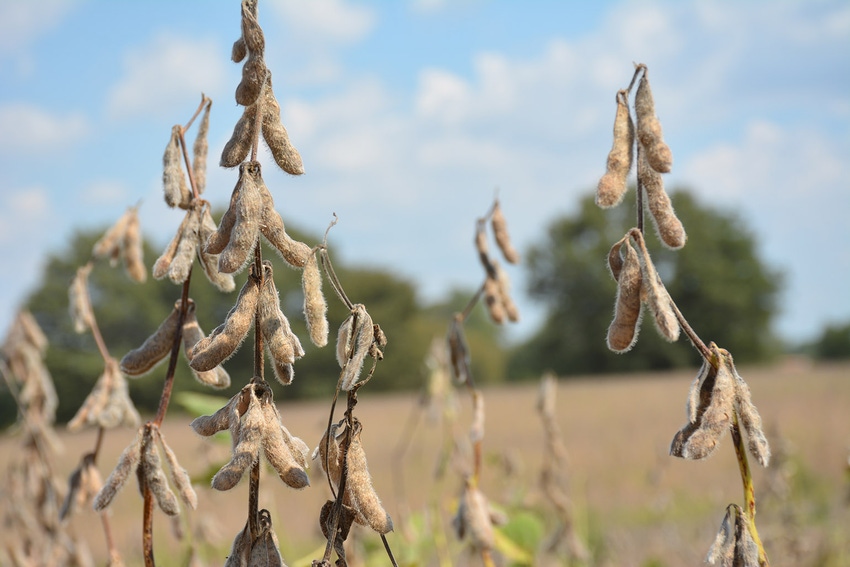January 16, 2019

The 2018 U.S. corn and soybean crops could be smaller than anticipated, but the market isn’t reacting with any certainty to that possibility because of the absence of USDA’s monthly crop production reports.
Under other circumstances, USDA’s National Agricultural Statistical Service would have released its annual Crop Production and Grain Stocks Reports on Friday, Jan. 11. But USDA has run out of funding due to the impasse between President Trump and congressional Democrats.
“The size of the 2019 crops remains up in the air because the USDA Jan. 11 report won’t be released,” said Bryce Knorr, senior grain market analyst for Farm Futures magazine, and a presenter for the University of Arkansas’ Food and Agribusiness Webinar on Thursday, Jan. 10. (To watch the webinar, go to https://youtu.be/RnDAFPKAdGM.)
“The USDA data vacuum is causing markets to be fairly choppy,” said Knorr, who has been following the markets for the magazine since 1987. “That’s one reason we saw prices so off today (Jan. 10), particularly in soybeans.”
Disappointment among commodity traders looking for evidence of new sales of U.S. soybeans to China was also being blamed for the lower prices.
Farm Futures, which is a sister publication to Delta Farm Press, released its own survey of growers’ harvest numbers the week of Jan. 1. Producers indicated they believed the corn crop was 200 million bushels smaller than USDA’s last forecast of 14.42 billion bushels, issued in November.
Lower corn acreage
“We’ve lowered the acreage a little bit for corn (to 81.4 million), and we also trimmed the yield for soybeans (to 51.6 bushels) and listed an even more substantial reduction in acres for soybeans (to 87.36 million),” said Knorr. “We found 1 million fewer acres than USDA’s last estimate, and, again, many areas had problems harvesting that crop.”
The survey put 2018-19 ending stocks at 1.69 billion bushels, about 90 million bushels lower than USDA’s November estimate for corn and at 758 million bushels, 157 million bushels less than the November forecast for soybeans.
Wheat stocks rose 54 million bushels to 1.03 billion from the November estimate by USDA, according to the Farm Futures estimates.
“The soybean carryout, if the crop is as small as we think it is, could be down,” he said. “Then we also could have perhaps a little bump in demand, if Chinese exports get going again. That could lower the carryout in soybeans at the end of the 2018 market year substantially.”
USDA’s January reports also usually include estimates of grain inventories, in terms of how much corn, soybeans, and wheat were available on Dec. 1. The Farm Futures survey asked growers for their thoughts on those numbers.
“We think with the smaller crop that the corn stocks could be about 567 million bushels less than a year ago,” Knorr said. “Beans went in the other direction with a very significant increase in soybean stocks. That’s one reason for bad prices we’ve seen. The wheat stocks are also higher than a year ago.”
Late harvest
The last USDA crop progress report of 2018 showed most areas outside Illinois and Missouri with significant amounts of corn and soybeans to harvest, and the harvest pace was lower than the five-year average in most of those states. “You folks down in Arkansas at the end of November still had about 12 percent of your soybeans to harvest; double digits behind average.
“Unfortunately, the slow harvest doesn’t necessarily mean a smaller crop,” he said. “We did see smaller crops in 1985 and 2008 when we had a relatively slow harvest pace in corn. But sometimes you have that slow harvest pace because you have a big crop, and it’s just taking longer to get out of the field.”
U.S. and Chinese negotiators wrapped up three days of meetings aimed at trying to end the tariff war earlier in the week of the webinar. The talks were scheduled after U.S. and Chinese trade officials agreed to a truce in which China’s President Xi said his country would buy more U.S. soybeans.
“But the year-to-date Chinese soybean shipments from us don’t even show up in the list of the 12 largest customers,” said Knorr. “Normally, China would be taking around 60 percent of our soybeans; now they’re included in the ‘other’ category. They’ve just accounted for 2 percent of our soybean inspections, which is one reason, of course, why prices have been so depressed.”
The winter months are typically the time of year China is buying large quantities of U.S. soybeans because the U.S. harvest has just been completed, and the South American crops are still growing in the field.
“Normally, we’d be capturing around 90 percent of their market in January,” said Knorr. “This year so far we’ve shipped only 15 million bushels. Brazil has shipped nearly double their usual amount for this time of the year.”
China reduced purchases
On the other hand, China has reduced its purchases across the board. “Not only is China buying fewer soybeans from the United States during the first quarter of our marketing year, they imported fewer soybeans from everybody, down about 9 percent compared to last year,” Knorr said. “And that’s right in line with what the Chinese government is trying to do.”
China’s economic growth is slowing, and, as its GDP growth has been trending lower, its increases in soybean imports have slowed, he said.
For more information on the University of Arkansas’ System Division of Agriculture’s Food and Agribusiness Webinars visit https://www.uaex.edu/farm-ranch/economics-marketing/food-agribusiness-webinars/.
About the Author(s)
You May Also Like






